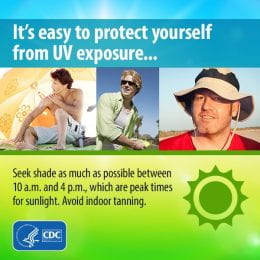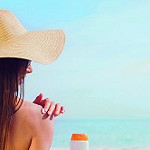 Sunscreen is an important part of sun safety but sunscreen alone isn’t enough to keep you safe from the sun. When used as directed, sunscreen is proven to decrease your risk of skin cancer and help prevent premature skin aging. Wearing sun protective clothing and sunglasses will also increase your protection from the sun. Use the following tips this summer (and year-round) to protect yourself from the sun.
Sunscreen is an important part of sun safety but sunscreen alone isn’t enough to keep you safe from the sun. When used as directed, sunscreen is proven to decrease your risk of skin cancer and help prevent premature skin aging. Wearing sun protective clothing and sunglasses will also increase your protection from the sun. Use the following tips this summer (and year-round) to protect yourself from the sun.
- Look for Broad spectrum: This sunblock Protects your skin from both UVA and UVB rays.
- Use SPF 30 or higher: Necessary for extended outdoor activities, including distance running, hiking, swimming and outdoor sports. SPF 30 is a must if you work outdoors.
- Use water resistant and very water-resistant Sunscreens: Sunscreens labeled water resistant are tested to be effective for up to 40 minutes of swimming, while very water-resistant sunscreens stay effective for up to 80 minutes in the water.
- Wear dark colors: Dark or bright colors keep UV rays from reaching your skin by absorbing them rather than allowing them to penetrate.
- Choose loose clothes: Tight clothing can stretch and reduce the level of protection offered.
- Look for a UPF label: Some clothing makers provide UPF labels, which indicate exactly how much of the sun’s rays the garment can shield.
- Cover up: The more skin your outfit covers, the better your protection. Choose long-sleeved shirts and long pants or skirts.
- Wear sunglasses year-round: Sun damage to the eyes can occur any time of year. Adults and kids should wear sunglasses year-round and choose shades that block 99 to 100% of UVA and UVB light.
- Wear a hat: Choose a hat with at least a three-inch brim and tightly woven fabric (no holes) to protect your face and the top of your head.
- Be aware of clouds: The sun’s rays can pass through haze and clouds, so eye protection is important even when there is cloud cover.
- Take care near water, snow and sand: 80 percent or more of the sun’s rays reflect off of these surfaces, so that they hit your eyes and skin a second time.
- Seek shade: Whenever possible, especially during times when the sun is most intense (typically 10 AM – 4 PM).
Source: skincancer.org
By: Ashley Svaty


